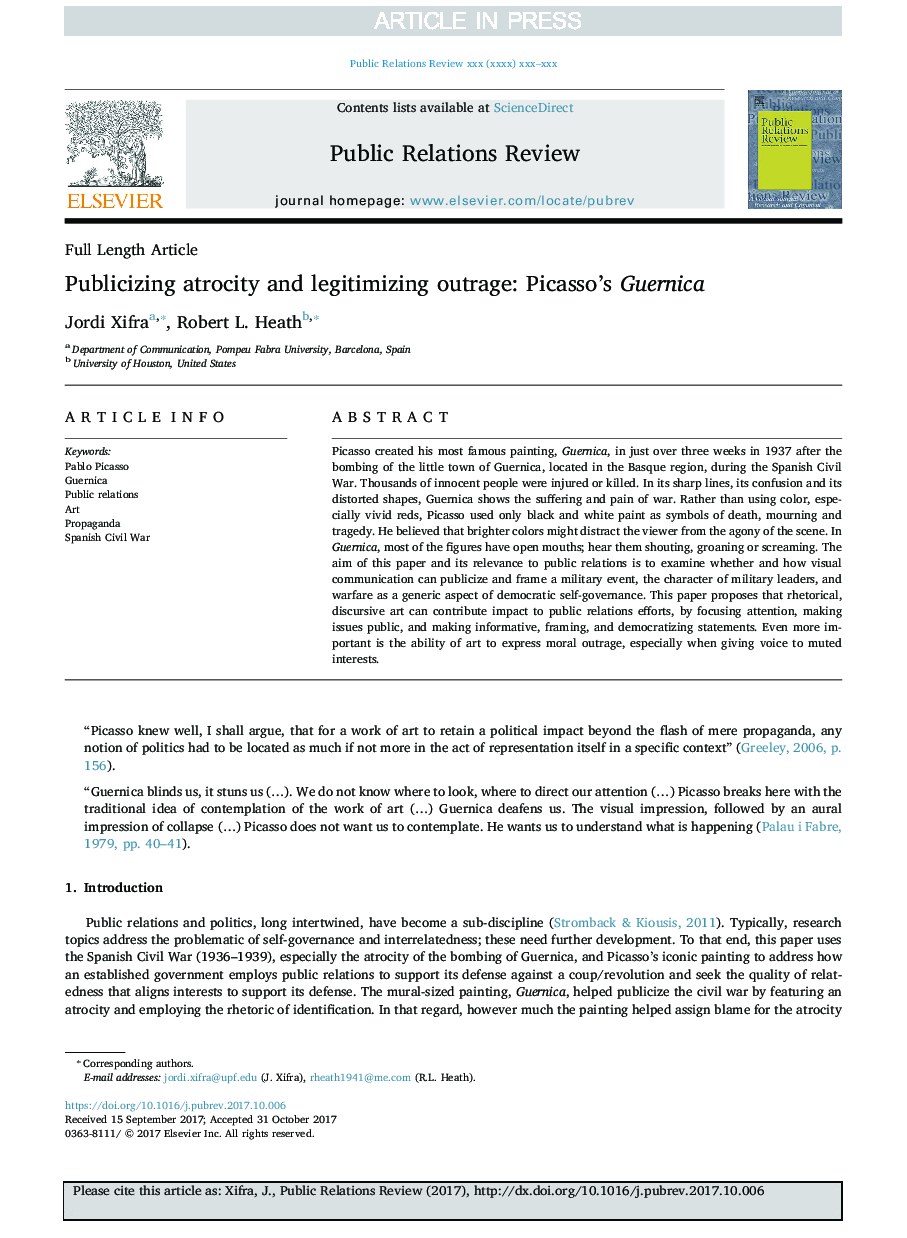| کد مقاله | کد نشریه | سال انتشار | مقاله انگلیسی | نسخه تمام متن |
|---|---|---|---|---|
| 6575861 | 1422776 | 2018 | 9 صفحه PDF | دانلود رایگان |
عنوان انگلیسی مقاله ISI
Publicizing atrocity and legitimizing outrage: Picasso's Guernica
ترجمه فارسی عنوان
انتشار جنایات و مشروعیت خشم: گورنیکا پیکاسو
دانلود مقاله + سفارش ترجمه
دانلود مقاله ISI انگلیسی
رایگان برای ایرانیان
کلمات کلیدی
پابلو پیکاسو، گورنیکا، روابط عمومی، هنر، تبلیغات جنگ داخلی اسپانیا،
ترجمه چکیده
پیکاسو معروف ترین نقاشی خود را، گورنیکا، در بیش از سه هفته در سال 1937 پس از بمباران شهر کوچکی از گورنیکا که در منطقه باسک در جنگ داخلی اسپانیا قرار داشت، ایجاد کرد. هزاران نفر بی گناه مجروح و یا کشته شدند. گورنیکا در خطوط تیز، سردرگمی و اشکال تحریف شده، رنج و درد جنگ را نشان می دهد. پیکاسو به جای استفاده از رنگ، بویژه رنگهای قرمز، تنها رنگ سیاه و سفید را به عنوان نماد مرگ، عزاداری و فاجعه استفاده کرد. او معتقد بود که رنگ های روشن تر می توانند بیننده را از درد و رنج صحنه منحرف کند. در گورنیکا، بیشتر ارقام دهان باز است؛ آنها را فریاد می زنند، می فهمند یا فریاد می زنند هدف این مقاله و ارتباط آن با روابط عمومی، بررسی اینکه آیا ارتباطات تصویری میتوانند یک رویداد نظامی، شخصیت رهبران نظامی و جنگ را به عنوان یک جنبه عمومی از حکومت دموکراتیک، تبلیغ کنند. این مقاله پیشنهاد می کند که هنر لفظی، گفتاری، می تواند تاثیر را بر تلاش های روابط عمومی، با تمرکز توجه، ایجاد مسائل عمومی و ایجاد اظهارات آموزنده، قابلیتی و دموکراتیزه، کمک کند. حتی مهمتر از آن این است که توانایی هنر برای ابراز خشم اخلاقی، به خصوص وقتی که صدای منافع را خاموش می کند.
موضوعات مرتبط
علوم انسانی و اجتماعی
مدیریت، کسب و کار و حسابداری
بازاریابی و مدیریت بازار
چکیده انگلیسی
Picasso created his most famous painting, Guernica, in just over three weeks in 1937 after the bombing of the little town of Guernica, located in the Basque region, during the Spanish Civil War. Thousands of innocent people were injured or killed. In its sharp lines, its confusion and its distorted shapes, Guernica shows the suffering and pain of war. Rather than using color, especially vivid reds, Picasso used only black and white paint as symbols of death, mourning and tragedy. He believed that brighter colors might distract the viewer from the agony of the scene. In Guernica, most of the figures have open mouths; hear them shouting, groaning or screaming. The aim of this paper and its relevance to public relations is to examine whether and how visual communication can publicize and frame a military event, the character of military leaders, and warfare as a generic aspect of democratic self-governance. This paper proposes that rhetorical, discursive art can contribute impact to public relations efforts, by focusing attention, making issues public, and making informative, framing, and democratizing statements. Even more important is the ability of art to express moral outrage, especially when giving voice to muted interests.
ناشر
Database: Elsevier - ScienceDirect (ساینس دایرکت)
Journal: Public Relations Review - Volume 44, Issue 1, March 2018, Pages 28-36
Journal: Public Relations Review - Volume 44, Issue 1, March 2018, Pages 28-36
نویسندگان
Jordi Xifra, Robert L. Heath,
